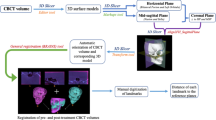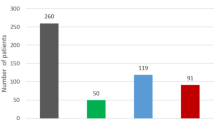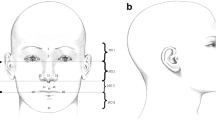Abstract
Purpose
The current assessment of patients with craniofacial asymmetries is accomplished by physical examination, anamnesis and radiological imaging. We propose a semi-automated, computer-assisted craniofacial evaluation (SymMetric v 1.0) based on orthogonal photography of the patient’s head in 3 positions. The system is simple, low-cost, no-radiation or special resources needed. Although it does not substitute CT in cases of doubt between craniosynostosis and positional plagiocephaly, multiple numeric evaluations indicate regional deformities and severity of the asymmetry, which can help in the clinical decision of indicating or not the orthosis in positional deformities, determining treatment duration or evaluating surgical outcomes after correction.
Methods
A Matlab-based tool was developed for digital processing of photographs taken in 3 positions (anterior, superior and lateral). The software guides the user to select visible and reproducible landmarks in each photograph acquisition and calculates multiple indexes and metrics, generating a set of comprehensive plots to offer the user an overview of head and facial symmetry across the orthogonal views. For purposes of demonstration, we evaluated 2 patients (one control and one with non-sinostotic deformity).
Results
The results show a clear differentiation of the control and plagiocephalic patient metrics mainly in the superior view, showing potential for diagnosis of the condition, and also detected the clinical improvement during helmet treatment in the follow-up, 3 and 5 months after orthosis’ use.
Conclusion
We presented a proof-of-concept for a low cost, no radiation evaluation system for craniofacial asymmetries, that can be useful in a clinical context for diagnosis and follow-up of patients.





Similar content being viewed by others
References
Argenta LC, David LR, Wilson JA, Bell WO (1996) An increase in infant cranial deformity with supine sleeping position. J Craniofac Surg 7:5–11
Kane AA, Mitchell LE, Craven KP, Marsh JL (1996) Observations on a recent increase in plagiocephaly without synostosis. Pediatrics 97:877–885
Turk AE, McCarthy JG, Thorne CH, Wisoff JH (1996) The “back to sleep campaign” and deformational plagiocephaly: is there cause for concern? J Craniofac Surg 7:12–18
McKinney CM, Cunningham ML, Holt VL, Leroux B, Starr JR (2008) Characteristics of 2733 cases diagnosed with deformational plagiocephaly and changes in risk factors over time. Cleft Palate Craniofac J 45:208–216. https://doi.org/10.1597/06-227.1
Kim HY, Chung YK, Kim YO (2014) Effectiveness of helmet cranial remodeling in older infants with positional Plagiocephaly. Arch Craniofac Surg 15:47–52. https://doi.org/10.7181/acfs.2014.15.2.47
Vargo JD, Hasan A, Andrews BT (2018) Identification and Management of Cranial Anomalies in perinatology. Clin Perinatol 45:699–715. https://doi.org/10.1016/j.clp.2018.07.008
Loveday BP, de Chalain TB (2001) Active counterpositioning or orthotic device to treat positional plagiocephaly? J Craniofac Surg 12:308–313
McGarry A, Dixon MT, Greig RJ, Hamilton DR, Sexton S, Smart H (2008) Head shape measurement standards and cranial orthoses in the treatment of infants with deformational plagiocephaly. Developmental Medicine & Child Neurology 50:568–576. https://doi.org/10.1111/j.1469-8749.2008.03017.x
Likus W, Bajor G, Gruszczyńska K et al (2014) Cephalic index in the first three years of life: study of children with Normal brain development based on computed tomography. Sci World J 2014:1–6. https://doi.org/10.1155/2014/502836
Schmid K, Marx D, Samal A (2008) Computation of a face attractiveness index based on neoclassical canons, symmetry, and golden ratios. Pattern Recogn 41:2710–2717. https://doi.org/10.1016/j.patcog.2007.11.022
Prendergast PM (2012) Facial Proportions. In: Erian A, Shiffman MA (eds) Advanced surgical facial rejuvenation. Springer, Berlin Heidelberg, Berlin, Heidelberg, pp 15–22
Al-Shaqsi SZ, Rai A, Forrest C, Phillips J (2018) Standardization of cranial index measurement in sagittal Craniosynostosis. J Craniofac Surg. https://doi.org/10.1097/SCS.0000000000005034
Miranda R, Matayoshi S, Brabo J, Miyoshi L (2001) Uso da estereofotogrametria para mensuração do volume da anatomia externa da face: revisão sistemática. Revista Brasileira de Cirurgia Plástica 33:572–579. https://doi.org/10.5935/2177-1235.2018RBCP0180
Lowe DG (1999) Object recognition from local scale-invariant features. In: proceedings of the seventh IEEE international conference on computer vision. IEEE, Kerkyra, Greece, pp 1150–1157 vol.2
Geng C, Jiang X (2009) SIFT features for face recognition. In: 2009 2nd IEEE international conference on computer science and information technology. Pp 598–602
Author information
Authors and Affiliations
Corresponding author
Ethics declarations
Conflict of interest
On behalf of all authors, the corresponding author states that there is no conflict of interest.
Additional information
Publisher’s note
Springer Nature remains neutral with regard to jurisdictional claims in published maps and institutional affiliations.
Electronic supplementary material
Rights and permissions
About this article
Cite this article
Lopes Alho, E.J., Rondinoni, C., Furokawa, F.O. et al. Computer-assisted craniometric evaluation for diagnosis and follow-up of craniofacial asymmetries: SymMetric v. 1.0. Childs Nerv Syst 36, 1255–1261 (2020). https://doi.org/10.1007/s00381-019-04451-2
Received:
Accepted:
Published:
Issue Date:
DOI: https://doi.org/10.1007/s00381-019-04451-2




